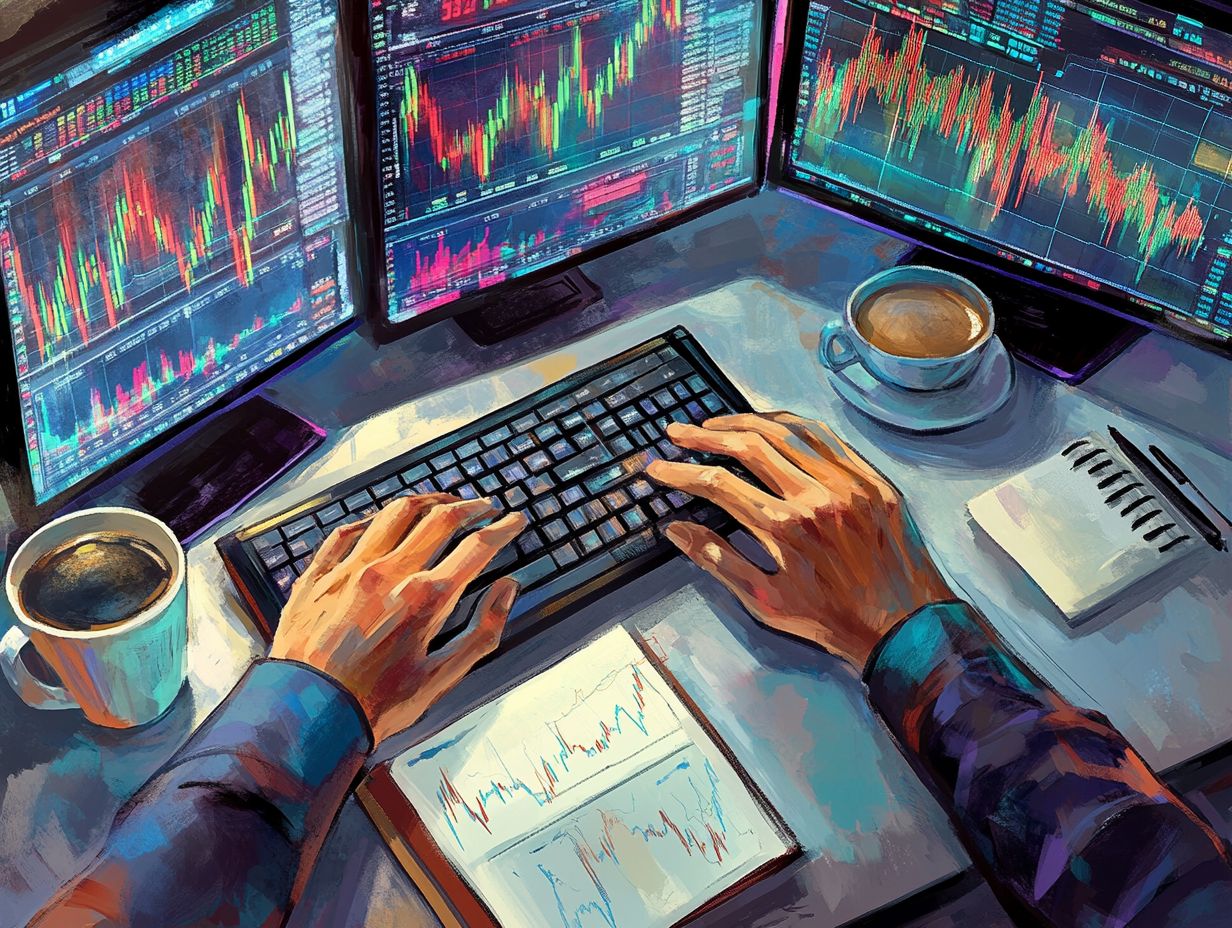The Psychology Behind Technical Analysis
Understanding technical analysis transcends mere charts and trends; it ventures into the complex realm of human psychology.
Your emotions, biases, and mental health play a pivotal role in shaping your trading decisions. Often, they steer you toward common pitfalls such as overconfidence, fear, and greed.
This article delves into the psychological barriers that traders encounter, providing you with strategies to uphold discipline and objectivity.
By acknowledging the impact of your emotions and implementing effective risk management techniques, you can significantly enhance both your trading performance and overall well-being. Embark on this journey with us as we explore this essential dimension of trading success.
Contents
- Key Takeaways:
- What is Technical Analysis?
- The Role of Psychology in Technical Analysis
- Common Psychological Pitfalls in Technical Analysis
- Strategies for Overcoming Psychological Barriers
- The Importance of Mental Health in Trading
- Frequently Asked Questions
- What is the psychology behind technical analysis?
- Why is understanding the psychology behind technical analysis important?
- How does psychology influence technical analysis?
- Can psychology be used to predict market movements?
- How can investors use psychology in technical analysis?
- Are there any risks associated with relying on psychology in technical analysis?
Key Takeaways:

- Emotions and biases can significantly impact trading decisions in technical analysis, leading to potential losses.
- Overcoming psychological barriers such as overconfidence, confirmation bias, fear, and greed is crucial for successful technical analysis.
- Maintaining discipline, objectivity, and implementing proper risk management techniques are essential strategies for managing emotions in technical analysis.
What is Technical Analysis?
Technical analysis is an advanced method that you, as a trading participant, can leverage to evaluate financial markets and unveil potential price movements. By scrutinizing historical price trends, market psychology, and various technical indicators, you can gain valuable insights.
This method includes examining price charts and tools such as the Moving Average Convergence Divergence (MACD), which shows changes in momentum, and the Relative Strength Index (RSI). These indicators help you gauge market sentiment and make informed predictions about future price action.
The Role of Psychology in Technical Analysis
Market psychology significantly influences technical analysis, impacting the emotional responses and investment decisions of traders like yourself. By grasping the intricate relationship between crowd behavior and price fluctuations, you can uncover the underlying sentiments that propel market dynamics, including insights from the psychology of risk taking in trading.
This understanding guides you toward effective trading strategies while helping you avoid potential pitfalls rooted in emotional decision-making.
How Emotions and Biases Affect Trading Decisions
Emotions such as fear and greed can profoundly influence your trading decisions, often leading you into psychological traps that undermine your strategies and discipline. Recognizing how these emotional responses manifest helps you make better investment choices.
For example, when market sentiment shifts to the negative, fear can prompt you to hastily sell off your holdings, worried about further losses. This reaction often triggers a domino effect, driving prices down a classic case of panic selling.
On the flip side, when the market experiences an upswing, the temptation of potential gains may stir greed within you, leading you to overlook fundamental analysis in pursuit of fleeting trends.
Such behaviors highlight how biases can trigger a herd instinct, resulting in irrational actions that derail your meticulously crafted trading plans. Real-world scenarios, like the dot-com bubble or the 2008 financial crisis, serve as stark reminders of how emotional responses can overshadow rational decision-making. This underscores the critical role of emotional awareness in successful trading.
Common Psychological Pitfalls in Technical Analysis

Common psychological pitfalls in technical analysis can easily derail even the most disciplined traders, potentially leading to critical trading mistakes and significant losses. You may find that overconfidence and confirmation bias frequently cloud your judgment, while the emotional states of fear and greed can further exacerbate poor decision-making. For deeper insights, explore understanding market sentiment.
It’s essential to remain aware of these challenges to navigate the trading landscape more effectively.
Overconfidence and Confirmation Bias
Overconfidence can lead you to underestimate risks. Confirmation bias nudges you to favor information that aligns with your beliefs, effectively blinding you to contrary evidence. Together, these mental traps can significantly impair your risk management and lead to costly trading mistakes.
Make it a habit to regularly assess your decision-making process! Review past trades to identify patterns influenced by overconfidence or biased information selection.
To counteract these biases, consider employing techniques such as:
- Setting strict risk parameters: Define clear limits on your trades to minimize losses.
- Utilizing systematic trading strategies: Adopt a set of rules for trading to maintain consistency.
- Maintaining a diversified portfolio: Spread your investments to reduce risk.
Fostering humility and openness helps you challenge your beliefs, ultimately leading to more informed and balanced trading decisions. Prioritize self-awareness and critical thinking to cultivate a healthier mindset. Doing so not only improves your trading performance but also enhances your risk management capabilities.
Fear and Greed
Fear and greed are two potent emotions that can significantly influence market sentiment. They often lead to impulsive trading decisions. These feelings can drive you to enter or exit positions at the wrong moments, perpetuating a cycle of mistakes and increasing volatility in financial markets.
For example, during a market downturn, fear may prompt you to sell your assets prematurely, worried about incurring larger losses. This only amplifies the decline. On the flip side, in a bullish market, greed can push you toward risky behavior. You may chase soaring prices without conducting the necessary analysis.
This emotional rollercoaster can trigger substantial price movements, leading to missed opportunities or regrettable losses. To manage these emotions effectively, consider implementing strategies like:
- Setting predefined exit points: Know when to exit trades to secure profits or limit losses.
- Practicing mindfulness: Use techniques to stay calm and focused.
- Adhering to a disciplined trading plan: Stick to your strategy to avoid emotional reactions.
This can help you counteract the instinctual urges that fear and greed often provoke.
Strategies for Overcoming Psychological Barriers
To conquer the psychological barriers in trading, it’s essential to adopt effective strategies that foster discipline and robust risk management.
By acknowledging the influence of behavioral biases and employing structured approaches, you can significantly elevate your decision-making processes and enhance your overall performance.
Maintaining Discipline and Objectivity

Maintaining discipline and objectivity in trading is crucial for your long-term success. It allows you to stay focused and minimizes the influence of emotional responses. To achieve this, consider setting strict parameters for your entry and exit points. Regularly review your trading performance against clearly defined objectives.
Establishing a routine can significantly bolster your emotional regulation and give you the power to analyze market conditions without succumbing to impulsivity. Incorporating mindfulness techniques, like meditation or deep-breathing exercises, can also help calm your mind, enabling you to assess each trade more objectively.
Creating a supportive environment is essential. Surround yourself with like-minded individuals who encourage disciplined trading habits and provide constructive feedback. Keeping a trading journal is another powerful tool in your arsenal. It highlights patterns in your decision-making and emotional triggers, fostering greater self-awareness and enhancing your ability to navigate psychological barriers.
Don t wait! Start building your disciplined trading habits today!
Utilizing Risk Management Techniques
Effective risk management techniques are crucial for traders. They help minimize losses and navigate the psychological hurdles of market corrections.
Using strategies like stop-loss orders and proper position sizing protects your capital. These techniques also help maintain emotional stability.
These techniques safeguard your financial assets. They instill discipline that prevents impulsive decisions driven by fear or greed.
For example, leveraging trailing stops locks in profits while allowing positions to grow. This helps counter anxiety during fluctuating market conditions.
Implementing a risk-reward ratio guides your trading decisions. It keeps your focus on long-term success rather than short-term setbacks.
By applying these strategies, you cultivate a resilient trading mindset. This enhances your overall performance and your ability to weather market storms.
The Importance of Mental Health in Trading
Mental health is a pivotal element in trading. It profoundly impacts performance and decision-making.
Elevated stress levels and burnout can alter your emotional state. They can tempt you into psychological traps that lead to less-than-ideal trading choices.
Recognizing this connection is essential. It helps maintain clarity and composure in trading s fast-paced world.
Recognizing and Managing Stress and Burnout
Managing stress and burnout is crucial for optimal trading performance. Prolonged high stress clouds judgment and leads to poor decision-making.
Identifying signs of stress allows you to take proactive steps to alleviate it. Common indicators include irritability, fatigue, and difficulty concentrating.
Over time, these symptoms escalate. They affect not just you but also your teamwork abilities.
Establishing realistic goals creates a manageable workload. These targets help you avoid overwhelming situations.
Building a supportive network of fellow traders provides vital encouragement. They can offer perspective during challenging times.
Incorporating self-care practices like exercise or mindfulness enhances mental resilience. This ultimately leads to better trading outcomes.
Frequently Asked Questions

What is the psychology behind technical analysis?
The psychology behind technical analysis studies human behavior in financial markets. It explores the psychology of market trends and how emotions impact price movements.
Why is understanding the psychology behind technical analysis important?
Understanding this psychology helps investors make more informed decisions. Recognizing patterns in market behavior minimizes risk.
How does psychology influence technical analysis?
Psychology influences technical analysis in various ways. Understanding the psychology of trading strategies can help recognize how human emotions like fear and greed can lead to predictable market patterns.
Can psychology be used to predict market movements?
While psychology provides insights, it cannot definitively predict future movements. It should complement other analysis methods for accuracy.
How can investors use psychology in technical analysis?
Investors can apply psychology in technical analysis. Understanding emotional reactions and the psychology of market cycles helps them see how these feelings affect market movements.
They can also use tools like sentiment analysis, which gauges how investors feel about the market, and behavioral finance, which studies how emotions influence financial decisions.
Are there any risks associated with relying on psychology in technical analysis?
Understanding psychology benefits investors. However, it’s only one part of technical analysis.
Relying too much on psychological factors can lead to biased interpretations. To succeed, investors should embrace a well-rounded approach, looking at all market data for the best insights.






